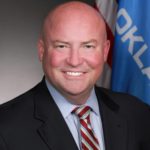By Oklahoma Institute for Child Advocacy CEO Joe Dorman
Gov. Kevin Stitt and legislative leaders have announced an agreement for the key elements to the Fiscal Year 2026 state budget.
The plan for the estimated $12.6 billion budget includes an income tax cut of a quarter percent and consolidation of the lowest income tax brackets. Based on modeling from the Institute for Taxation and Economic Policy, a 0.25% cut to Oklahoma’s personal income tax rate is estimated to reduce collections by $338 million annually. By flattening the bottom three income tax brackets, this is expected to lower the state budget by $87 million annually.
The negotiating parties agreed on key spending priorities, including funds for a new, state-of-the-art veterinary hospital at OSU in Stillwater for $250 million; a world-class pediatric heart hospital at OU in Oklahoma City for $200 million; and funds for various infrastructure investments across the state.
Other items in the budget include the purchase of a private prison in Lawton for $312 million and funding for the Department of Mental Health and Substance Abuse Services so they can make payroll for the rest of this fiscal year ending June 30. There will also be $41.6 million for the Oklahoma National Guard to do needed maintenance and $5 million for state employee maternity leave costs.
“Enhanced tort reform” is included in the agreement, further limiting lawsuits against doctors and some businesses. Other “business-friendly” policies include “Behind the Meter” to allow power generation by large-scale manufacturers and data centers, the establishment of business courts, and expense recovery for utilities.
The agreement also boosts public school funding by $25 million and private school vouchers by $50 million, while raising the ceiling on teacher pay. A pair of programs — for statewide inhaler access and school panic buttons — will be moved out of the State Department of Education into other agencies. The deal also will make the children of teachers eligible for the Oklahoma Higher Learning Access Program scholarships.
Lawmakers are spending $8 million for a partnership between the OSU Medical Authority and St. Francis Hospital to capture federal funding to establish a Level 1 trauma center in Tulsa; currently, the state’s only Level 1 trauma center is in Oklahoma City.
Lawmakers must constitutionally adjourn by 5 p.m. on the final Friday in May. These agreements, along with other bills yet unresolved, must make it to the desk of the governor by then.
Many issues discussed this year, including an increase of $5 per day for traditional foster care to meet the growing costs of the economy – a detriment to recruiting much-needed foster families – will be held over until next year.
Some have called for eliminating the state’s income tax. This would slash an estimated $5.8 billion annually from the current state budget. Obviously, many government services such as public schools, SoonerCare, and highway maintenance would face severe shortages if this were to happen.
Of great concern, state lawmakers still do not know the impact of cuts looming with the upcoming federal budget. In Oklahoma, our state budget includes 43-47% matching federal funds. Early indicators predict that there will likely be between $400-$800 million of federal funds to Oklahoma eliminated. This could require some potentially unpleasant actions.
One is a special session to modify the budget. Governor Stitt would need to call lawmakers back to adjust agency allocations, or lawmakers could try to call themselves back by a two-thirds vote of both the state House of Representatives and Senate. The second option is for agencies to absorb those cuts in the programs funded by federal dollars and reduce services.
There are still many unknowns about what will happen with the federal budget. The Oklahoma Institute for Child Advocacy will keep you informed once more is revealed.


